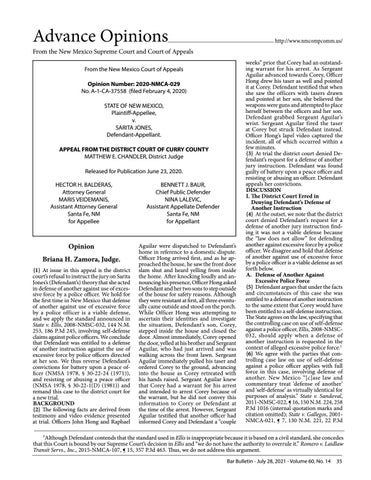Advance Opinions
http://www.nmcompcomm.us/
From the New Mexico Supreme Court and Court of Appeals From the New Mexico Court of Appeals Opinion Number: 2020-NMCA-029 No. A-1-CA-37558 (filed February 4, 2020) STATE OF NEW MEXICO, Plaintiff-Appellee, v. SARITA JONES, Defendant-Appellant. APPEAL FROM THE DISTRICT COURT OF CURRY COUNTY MATTHEW E. CHANDLER, District Judge Released for Publication June 23, 2020. HECTOR H. BALDERAS, Attorney General MARIS VEIDEMANIS, Assistant Attorney General Santa Fe, NM for Appellee
Opinion Briana H. Zamora, Judge. {1} At issue in this appeal is the district court’s refusal to instruct the jury on Sarita Jones’s (Defendant’s) theory that she acted in defense of another against use of excessive force by a police officer. We hold for the first time in New Mexico that defense of another against use of excessive force by a police officer is a viable defense, and we apply the standard announced in State v. Ellis, 2008-NMSC-032, 144 N.M. 253, 186 P.3d 245, involving self-defense claims against police officers. We conclude that Defendant was entitled to a defense of another instruction against the use of excessive force by police officers directed at her son. We thus reverse Defendant’s convictions for battery upon a peace officer (NMSA 1978, § 30-22-24 (1971)), and resisting or abusing a peace officer (NMSA 1978, § 30-22-1(D) (1981)) and remand this case to the district court for a new trial. BACKGROUND {2} The following facts are derived from testimony and video evidence presented at trial. Officers John Hong and Raphael
BENNETT J. BAUR, Chief Public Defender NINA LALEVIC, Assistant Appellate Defender Santa Fe, NM for Appellant
Aguilar were dispatched to Defendant’s home in reference to a domestic dispute. Officer Hong arrived first, and as he approached the house, he saw the front door slam shut and heard yelling from inside the home. After knocking loudly and announcing his presence, Officer Hong asked Defendant and her two sons to step outside of the house for safety reasons. Although they were resistant at first, all three eventually came outside and stood on the porch. While Officer Hong was attempting to ascertain their identities and investigate the situation, Defendant’s son, Corey, stepped inside the house and closed the door. Almost immediately, Corey opened the door, yelled at his brother and Sergeant Aguilar, who had just arrived and was walking across the front lawn. Sergeant Aguilar immediately pulled his taser and ordered Corey to the ground, advancing into the house as Corey retreated with his hands raised. Sergeant Aguilar knew that Corey had a warrant for his arrest and intended to arrest Corey because of the warrant, but he did not convey this information to Corey or Defendant at the time of the arrest. However, Sergeant Aguilar testified that another officer had informed Corey and Defendant a “couple
weeks” prior that Corey had an outstanding warrant for his arrest. As Sergeant Aguilar advanced towards Corey, Officer Hong drew his taser as well and pointed it at Corey. Defendant testified that when she saw the officers with tasers drawn and pointed at her son, she believed the weapons were guns and attempted to place herself between the officers and her son. Defendant grabbed Sergeant Aguilar’s wrist. Sergeant Aguilar fired the taser at Corey but struck Defendant instead. Officer Hong’s lapel video captured the incident, all of which occurred within a few minutes. {3} At trial the district court denied Defendant’s request for a defense of another jury instruction. Defendant was found guilty of battery upon a peace officer and resisting or abusing an officer. Defendant appeals her convictions. DISCUSSION I. The District Court Erred in Denying Defendant’s Defense of Another Instruction {4} At the outset, we note that the district court denied Defendant’s request for a defense of another jury instruction finding it was not a viable defense because the “law does not allow” for defending another against excessive force by a police officer. We disagree and hold that defense of another against use of excessive force by a police officer is a viable defense as set forth below. A. Defense of Another Against Excessive Police Force {5} Defendant argues that under the facts and circumstances of this case she was entitled to a defense of another instruction to the same extent that Corey would have been entitled to a self-defense instruction. The State agrees on the law, specifying that the controlling case on use of self-defense against a police officer, Ellis, 2008-NMSC032, should apply when a defense of another instruction is requested in the context of alleged excessive police force.1 {6} We agree with the parties that controlling case law on use of self-defense against a police officer applies with full force in this case, involving defense of another. New Mexico “[c]ase law and commentary treat ‘defense of another’ and ‘self-defense’ as virtually identical for purposes of analysis.” State v. Sandoval, 2011-NMSC-022, ¶ 16, 150 N.M. 224, 258 P.3d 1016 (internal quotation marks and citation omitted); State v. Gallegos, 2001NMCA-021, ¶ 7, 130 N.M. 221, 22 P.3d
1Although Defendant contends that the standard used in Ellis is inappropriate because it is based on a civil standard, she concedes that this Court is bound by our Supreme Court’s decision in Ellis and “we do not have the authority to overrule it.” Romero v. Laidlaw Transit Servs., Inc., 2015-NMCA-107, ¶ 15, 357 P.3d 463. Thus, we do not address this argument. Bar Bulletin - July 28, 2021 - Volume 60, No. 14
35





